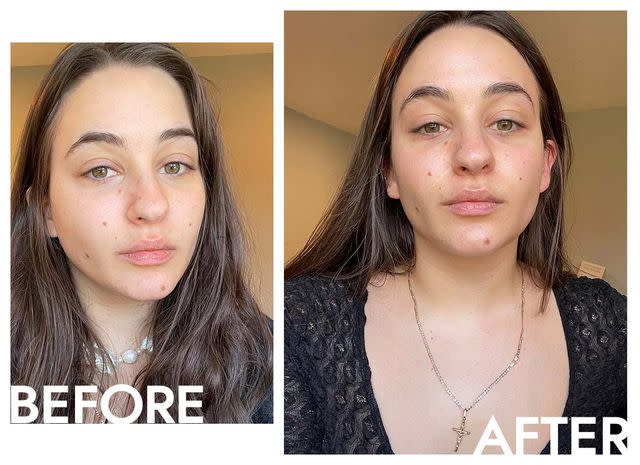I Tried TikTok's "Tantouring" Trend, and It Actually Works
I'm as shocked as you are.

Isabella Sarlijia
Over the past decade or two, the biggest online beauty trends have always been all about contour— from Youtubers dusting Nars Laguna Bronzer all over their faces, to Instagram influencers creating geometric lines with specialty cream contour products. Adding a subtle glow and definition has pretty much always been around, and now people on TikTok are favoring a softer and longer-lasting bronzing and contour technique: "tantouring."
Ahead, everything you need to know about the viral trend.
What is Tantouring?
As the name suggests, tantouring is a contoure technique that utilizes self-tanner to create a long-lasting sculpt. TikTokers apply self-tanner to the areas that they would typically contour, like the cheekbones, jawline, hairline, and sides of their nose. In addition to creating definition that lasts for days, tantouring also adds a subtle bronze to your complexion.
What Are the Benefits of Tantouring?
Permanent makeup techniques have been around for what feels like forever because they help people look as though they’re wearing makeup 24/7. Unfortunately, traditional permanent makeup (like microblading and eyeliner tattoos) can have their downfalls since trends are ultimately fleeting. Tantouring, however, doesn’t rely on treatments that will make your skin glow forever, but simply uses a long-lasting product to stain your skin for a few days, helping you appear as though you're wearing makeup from the moment you wake up.
How to Tantour
I’ll admit: My relationship with self-tanner generally isn’t great. I can never quite figure out how to create a bronzed glow sans weird blotches and streaks. Still, with the help of user @imonaugust's thorough instructions, I was able to nail tantouring—here's how.
Choose a Self-Tanner That Fits Your Needs
Tantouring has a one-two punch of both defining your bone structure the way contouring does, and adding a sun-kissed glow like bronzer. If you enjoy having both product types in your routine, opt for a self-tanner with neutral tones to add warmth and dimension to your skin. If you want to go the bronzier route, choose a self-tanner with warm undertones. And if you’re only after creating a long-lasting contour, choose a self-tanner with green or cool undertones.
And although there are countless self-tanners out there that are specifically formulated for the face, you can really use any self-tanner (even if it’s for the body) to mimic a bronzed and contoured effect.
Exfoliate
Before applying any self-tanner on your face or body, it is critical to start with skin that's free of product, grime, and dead skin, as you can run the risk of the self-tanning pigments latching onto flakes or buildup, creating an uneven finish. First, use a gentle cleanser to remove your makeup and clean the skin, and then use a gentle physical exfoliator to slough off dead skin cells from the surface.
Add a Base Glow
If you decide to try this technique out during the wintertime, you might create a tantour that doesn’t blend into your current complexion. Personally, I started by spreading the St. Tropez Tan Tonic Glow Drops ($42) over my entire face, neck, and décolletage to add a subtle base glow and prep me for the tantouring technique.
Apply Self-Tanner
Using a contour brush, I first applied the St. Tropez Self Tan Classic Bronzing Mousse ($32) to the larger areas of my face, like my cheekbones, jawline, and hairline. Then, I blended in the product with a Beauty Blender ($20). After that, I grabbed an eyeshadow blending brush to "contour" the smaller parts of my face, applying the mousse to the sides of my nose, above and below the center of my lips, and in the crease of my eyes. I made sure to get rid of any harsh lines by blending with my Beauty Blender again.
Practice Patience
Most self-tanners develop overnight, so I made sure to do this technique directly before going to bed. After allowing the self-tanner to dry down, I went to sleep and washed my face off in the morning. Be aware, though: there are some fast-acting self-tanners out there that can work in as little as two hours—so make sure to follow the directions on your product’s packaging and wash the tanner off when it’s time.
Tantouring Before and After

Isabella Sarlijia
Honestly speaking, I reserved trying this technique out for a time when I knew I probably wouldn't run into anyone I kow for a few days after. I was pretty scared about this technique leaving me with harsh faux tanlines that would take days to come off. But, to my surprise, it left me with nothing but a defined face and a barely-there bronze.
I found that I didn’t need many complexion products in the days after tantouring because, well, the viral technique actually works at defining the face, adding a sun-kissed glow, and even blurring imperfections, the same way a real tan can. And the results really were long-lasting—even with my intense exfoliation routine, I found that the glow lasted me almost a full week. All in all, this hack completely revolutionized my relationship with self-tanners, and you can bet that I’ll be tantouring all year.
Up Next:

